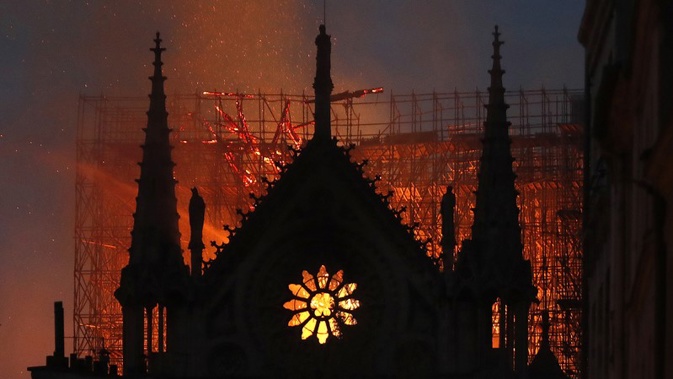But the much-loved gothic masterpiece has been in a perilously poor condition at many phases in its life.
The cathedral was located at the centre of the French capital in the Middle Ages and its construction was completed in the mid-12th century after some 200 years of work.
During the French Revolution in the 18th century, the cathedral was vandalised duing widespread anti-Catholic violence: its spire was dismantled, later to be rebuilt in the 19th century, its treasures plundered and its large statues at the grand entrance doors destroyed.
But it was reborn after Victor Hugo turned it into the key protagonist in his novel.
Shortly afterwards a restoration project lasting two decades got underway, led by architect Eugene Viollet-le-Duc. It survived two World Wars and its bells rang out on August 24, 1944, the day of the Liberation of Paris from German occupation at the end of the WWII.
"This is Paris' jewel in the crown," said Michel Picaud, head of the Friends of Notre Dame Foundation, which has been spearheading a campaign to gather private funds for its restoration.
/arc-anglerfish-syd-prod-nzme.s3.amazonaws.com/public/33FOWAIK5NDSNJESGLZ7BQDVFM.jpg)
An icon of the Paris skyline
Notre Dame de Paris cathedral, whose construction began in 1160, is an icon of the Paris skyline. Its facade stands 226ft tall.
Its name means literally "Our Lady of Paris" and the building is one of the finest examples of French Gothic architecture.
Notre Dame was desecrated in the 1789 French revolution, but was restored between 1845-1870 by the architect Eugene Viollet-le-Duc.
The restoration project was sparked partly as a result of the popularity of Victor Hugo's 1831 novel The Hunchback of Notre-Dame.
Until the completion of the Eiffel Tower in 1889, the towers of Notre Dame were the tallest structures in Paris.
The cathedral is famed for its three magnificent stained-glass rose windows which date from the 13th century.
Notre Dame houses three important relics: the Crown of Thorns, pieces of the True Cross and one of the Holy Nails from the crucifixion.
It is home to one of the finest pipe organs in Europe. The current instrument has 115 stops and more than 8,000 pipes.
The cathedral has 10 bells, with the largest, Emmanuel, weighing in at 13 tons. For centuries they have tolled at historic moments - from the coronation of kings to the end of two World Wars.


/arc-anglerfish-syd-prod-nzme.s3.amazonaws.com/public/OB527VSL3FC6LE4YZWN7XCOAD4.jpg)
/arc-anglerfish-syd-prod-nzme.s3.amazonaws.com/public/BPYD4DCLVJEFNLGW3F2QKWK7BU.jpg)








